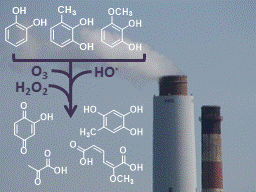Aromatic pollutants emitted during combustion and wood burning contribute to the formation of brown clouds

Aerosol particles suspended in the air of urban environments typically reduce visibility, interact with sunlight by scattering and absorbing radiation, and lower air quality. In addition, these tiny particles can also contribute large pollution plumes, called "brown clouds", which have been observed to originate over South Asia in recent years and undergo long distance transport by the wind to reach other continents. The particles in brown clouds are composed by an unhealthy and variable mix including ozone and organic molecules found in smoke.
A laboratory study entitled "Oxidation of Substituted Catechols at the Air-Water Interface: Production of Carboxylic Acids, Quinones, and Polyphenols" by scientists at the University of Kentucky now reveals how ozone can transform the organic molecules present in such smoke plumes.
The article published in Environmental Science and Technology reports the detailed chemical transformations of molecules emitted during forests fires, combustion in power plants, and industrial processes. The team of researchers determined that aromatic molecules can contribute to the formation of light-absorbing aerosols under relevant humid conditions.
Furthermore, the significant generation of new molecules such as pyruvic acid in these pollution plumes can trigger aerosol formation in the presence of light. Reactions occurring on interfaces and under high relative humidity, which may have been overlooked in the past, can actually be the source of light-absorbing organic components in aerosols.
More information: E. A. Pillar and M. I. Guzman. Oxidation of Substituted Catechols at the Air–Water Interface: Production of Carboxylic Acids, Quinones, and Polyphenols. Environ. Sci. Technol., 2017, 51 (9), pp 4951–4959. DOI: 10.1021/acs.est.7b00232. pubs.acs.org/doi/full/10.1021/acs.est.7b00232
Journal information: Environmental Science and Technology
Provided by University of Kentucky





















